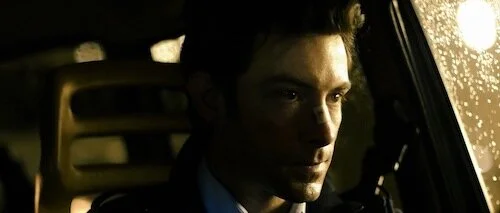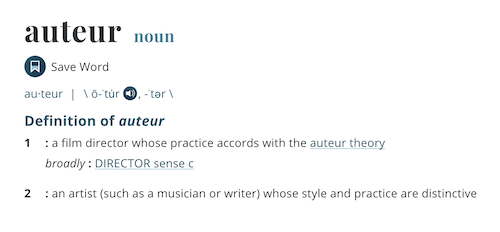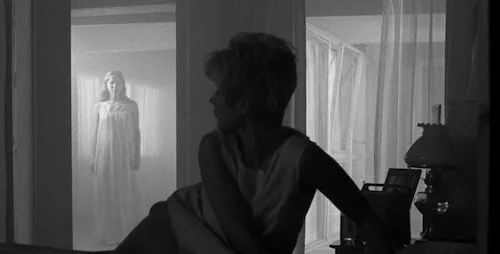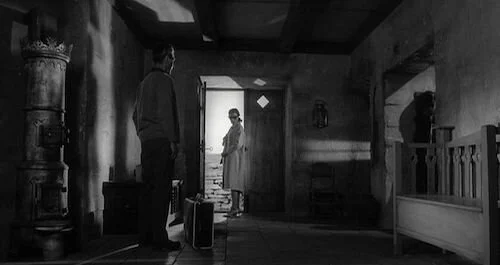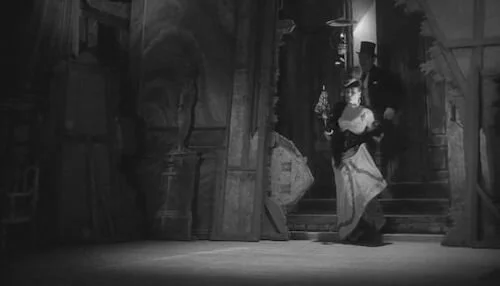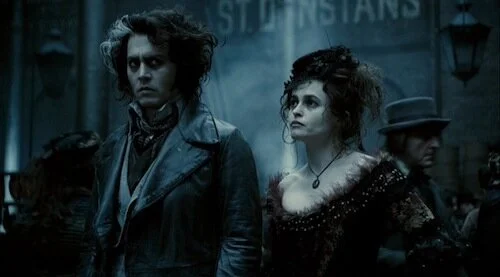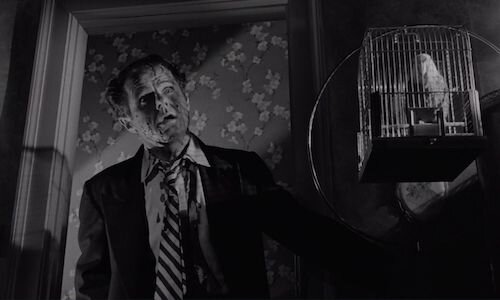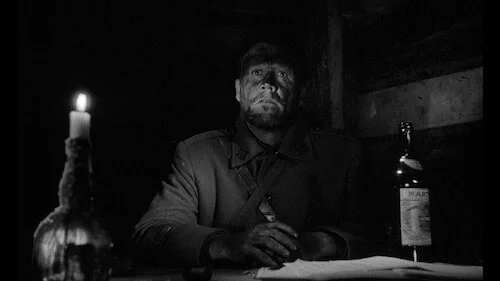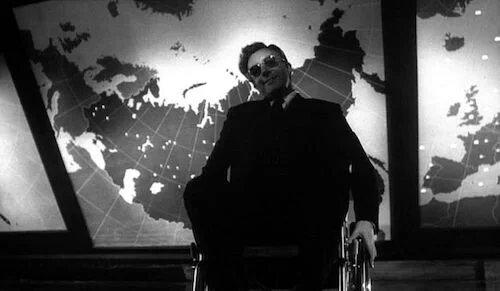What Exactly is an Auteur?
Likely you have seen the word “auteur” tossed around a lot when an article or review has discussed a specific filmmaker. In short, the word has been used to describe a filmmaker who has a signature style that can be identified throughout their body of work. In a more literal sense, here’s a dictionary definition.
From Merriam-Webster.
Just to double down, here is the definition for “auteur theory”, as described above.
From Merriam-Webster.
So the idea is that the director is the main person in charge of a film when they are described as an auteur. Some examples of auteurs regularly discussed in this topic include Tim Burton, Terrence Malick, Martin Scorsese, Ingmar Bergman, Quentin Tarantino and Stanley Kubrick.
That’s it. Article over, right? Well, actually. Today I want to briefly go into why this definition is not exactly accurate. I answered this very same question (what is an auteur?) in my Masters program, and was told I was wrong. It’s funny, because it’s almost incredibly obvious looking back that I was wrong, and that this definition that we have all adopted is skewed. To go into great detail, I’ll use an example.
Here are images from three Ingmar Bergman films. Notice the blurriness, lights and shadows, and deep focus.
Persona
Between these two images (above and below), there is a shadowy figure, an illuminated figure, a bright doorway, and a gloomy interior. You can suggest that Bergman loves working with lighting and shadows to convey mental instability in his psychological dramas.
Through a Glass Darkly
What if we go further back? Sawdust and Tinsel is hardly a psychological film (certainly not in the way the above two works are). Yet, we have a very similar visual style in this scene.
So, what do all of these films have in common outside of how these shots look? They were shot by Sven Nykvist: a frequent collaborator of Bergman’s for a great deal of time (Sawdust and Tinsel was their first film together).
On that note, here are a couple of other examples, attached to the names mentioned above.
Sweeney Todd: The Demon Barber of Fleet Street
Every single Tim Burton film since Edward Scissorhands has had costume work by Colleen Atwood.
Days of Heaven
Jack Fisk has done production design for nearly every single Terrence Malick film ever.
Ever since Raging Bull, Thelma Schoonmaker has edited every Martin Scorsese film.
So, from these examples, something is apparent. Much of what we identify with these filmmakers actually comes from those they closely work with, whether it is how a scene is shot, what people wear, what architecture is present, or how these images are presented together.
Before things get uncomfortable, we still have two names that haven’t been brought up again: Kubrick and Tarantino. So, let’s start off first with Stanley Kubrick: one of cinema’s most infamous perfectionists. Let’s do this exercise again. I’ll even give you black and white films once more. What is the same with these three images?
The Killing
Paths of Glory
Dr. Strangelove or: How I Learned to Stop Worrying and Love the Bomb
So, take a wild guess. This is all thanks to the same cinematographer, right?
Wrong.
In this particular scenario, you’re looking at the photography of Lucien Ballard, Georg Krause, and Gilbert Taylor, respectively. Yet, Kubrick’s low angle, shadowy images are still present throughout these ominous scenes. Well, this could be a special case, given that Kubrick was a photographer before he became a director, but that’s not exactly the point.
The message is that directors still are in charge of their films through and through, to varying degrees depending on the filmmaker and/or the project. If you were to compare Spartacus to other Kubrick Technicolor films, it would stand out because of his lack of control in this particular work (compared to how he usually operated). Regardless, a director still helps create specific moods and cinematic identities with these films. In order to do that, they work with their team. Not every visual director is like Alfonso Cuarón or Paul Thomas Anderson, who can shoot (or help shoot) their own films after enough years of experience. Not every director knows exactly how lighting or cameras work to such a level in order to do this. However, they know what they want, and they can work with the cinematographer to get this. The cinematographer can also make their own suggestions, or better the original vision, to get a better end result.
With that in mind, Bergman knew what lengths Nykvist was capable of, and Nykvist could channel Bergman’s visions enough to enhance them. Apply this same philosophy to the other pairings above.
A director may be in charge of a film (to an extent), but they also work vicariously through many other departments. A director can still have a signature style, but it could very well be enhanced by the team surrounding them. Wong Kar-wai still favoured visual aesthetics after severing ties with cinematographer Christopher Doyle, for instance. However, these levels of familiarity can be largely thanks to one or many partnerships a director has, especially if they love working together and want to keep achieving great end results. Directors don’t just like working with the same performers again and again.
We still have one director left to discuss. I’ve left Quentin Tarantino as the last main example for a reason.
WARNING: The following scene includes slight cases of violence. Reader discretion is advised.
WARNING: The following scene includes excessive violence. Reader discretion is advised.
Both of these Tarantino scenes have quick cuts in them, showcasing that typical exciting pacing his films usually carry. Yet, Django Unchained feels slightly different to Inglourious Basterds, doesn’t it? That’s because every film of his before Django Unchained was edited by long time editing partner Sally Menke, who sadly passed away in 2010. Tarantino worked with editor Fred Raskin on this film. You can tell the slight differences between Menke and Raskin.
Menke’s scene is a bit sharper with the cutting in the fast-paced moments, so there’s less room to breathe, creating more of a rush.
Raskin’s cutting is more open, so there’s a slight bit of air in between the images, letting us appreciate the images on screen more, but maybe feeling less intense.
Both editors are working to capture Tarantino’s fascination with having moments with a flurry of cuts, as a means of creating a miniature montage.
Before we wrap everything up, there are a few things to go over. No, Tarantino didn’t invent short bursts of cuts, and neither did these editors. However, it’s a style he favours and that these editors can perfect (in their own different ways). Many tropes and ideas have been circulating for the over one-hundred years of filmmaking’s history. It’s about know when to use what technique, image, sound, and et cetera. Again, directors will work with their cast and crew to get the best results. It’s a collaborative effort, with the filmmaker trying their best to string all of these ideas together as cohesively as possible.
Then you have extreme cases. Check out the following scene below from Upstream Color. It may be a bit difficult to follow outside of context (I recommend watching this entire, exquisite feature), but watch it for the benefit of this lesson: the directorial style.
Even though the film is experimentally assembled (it has much to do with the film’s hidden premise, which I won’t spoil for those of you that haven’t seen the film), it all makes sense aesthetically. How? The narrative is so fragmented. Did the director work with the right people?
If you’re unfamiliar with Upstream Color, it’s directed by Shane Carruth.
It’s also produced, written, starring, shot by, scored by and edited by Shane Carruth.
In this unique instance, Carruth is actually an auteur in the skewed definition, since he is not only in charge of all of these departments: he is actually the person doing all of this work himself. He’s not answering to a filmmaker’s requests. He’s fulfilling his own vision through and through. Many filmmakers will produce or write their own films, but a handful go the extra mile. Akira Kurosawa edited most of his own films. Clint Eastwood has tried scoring his own films occasionally. Steven Soderbergh will take on many responsibilities of his films depending on the project, ranging from production and screenwriting to photography and editing. Oftentimes, filmmakers will undergo pseudonyms; the Coen brothers have used the name “Roderick Jaynes” to cover their editing work in the past. Pseudonyms can be for a huge variety of personal reasons.
Outside of extreme cases like Shane Carruth or Steven Soderberg, the current definition of auteur — that a director’s signature style is entirely representative of them — is flawed enough to spend an entire lesson trying to clarify. Do some directors have specific traits that are identifiable? Absolutely. Do they work with their cast and crew to fulfill these goals? Yes. However, an auteur isn’t specifically responsible for literally everything you see. An auteur is open to collaborations. Sometimes these collaborations are what you’re seeing from film to film. Sometimes, it’s the director knowing explicitly what they want even with different collaborators. It’s good to know in each and every different context what’s really going on, because you can have a wider appreciation for the work of many (and not just one), and also understand the varying elements of filmmaking maybe a little bit more differently.
Andreas Babiolakis has a Masters degree in Film and Photography Preservation and Collections Management from Ryerson University, as well as a Bachelors degree in Cinema Studies from York University. His favourite times of year are the Criterion Collection flash sales and the annual Toronto International Film Festival.

